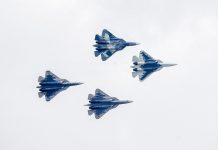The flight trials of Dhruvastra anti-tank guided missile (ATGM) was successfully conducted by Indian DRDO (Defence Research and Development Organization) at the Interim Test Range (ITR) in Odisha recently.
US Experts Blame Indian Home Minister Amit Shah For Galwan Valley Clash
According to ANI reports, the trials of the helicopter-launched Nag Missile, which has now been named as ‘Dhruvastra’ anti-tank guided missile, were conducted in direct and top attack mode on July 15 and 16.
#WATCH Trials of Helicopter-launched Nag Missile (HELINA), now named Dhruvastra anti-tank guided missile in direct and top attack mode. The flight trials were conducted on 15&16 July at ITR Balasore (Odisha). This is done without helicopter. pic.twitter.com/Jvj6geAGLY
— ANI (@ANI) July 22, 2020
Dhruvastra anti-tank guided missile is a third-generation ‘fire and forget’ ATGM system installed on the Advanced Light Helicopter (ALH). The Dhruvastra ATGM has all-weather day and night capability and can strike main battle tanks with conventional armour as well as explosive reactive armour.
The indigenously developed ATGM missile can engage targets both in the direct hit mode as well as top attack mode. Defence Research and Development Organisation (DRDO) last year carried out three successful test firings of the NAG (Dhruvastra) missiles in the Pokhran firing ranges.
The Dhruvastra anti-armour guided weapon’s airframe is built with lightweight and high-strength composite materials. The missile features top-attack capability and has high immunity to countermeasures.
The missile is equipped with four foldable wings and has a length of 1.85m, diameter of 0.20m, a wingspan of 0.4m and weight of 43kg.
A blunt nose cone houses the guidance system, while the middle portion accommodates a compact sensor package and the main charge of the warhead. A booster rocket motor is located towards the rear. Four tail fins are fitted at the rear to stabilise the missile while in flight.
A real-time image processor with fast and efficient algorithms is installed next to the guidance section to provide automatic target detection and tracking capabilities. The digital autopilot offers guidance, stability and control for the missile during the flight. Dhruvastra is also outfitted with an electric actuation system for flight control.




